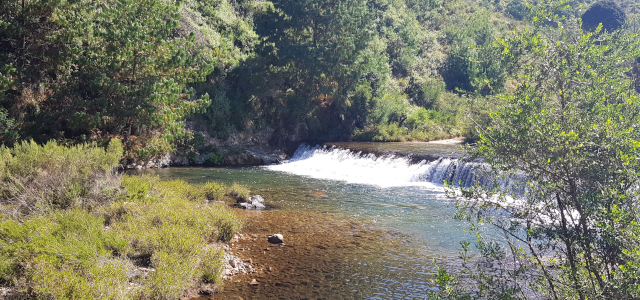In 2023, Global Water Partnership Southern Africa (GWPSA) commissioned an Environmental Flow (EFlows) assessment in the Pungwe Basin, aimed at identifying the driving processes and functioning of the river, estuary, and its ecosystems to understand their implications for the rivers, estuary, and nearshore ecosystems – their condition, ecological tipping points, and the services they provide to people. The study also assessed how various management approaches and water resource development scenarios might help deliver on the spirit and specifics of the Pungwe Basin Agreement. The assessment was conducted under the GEF- Funded USD 6 million “Management of Competing Water Uses and Associated Ecosystems in Pungwe, Buzi, and Save Basins ” Project, being implemented in the Buzi, Pungwe, and Save (BUPUSA) river basins by the International Union for Conservation of Nature (IUCN), with Global Water Partnership Southern Africa (GWPSA) as the regional executing Partner.
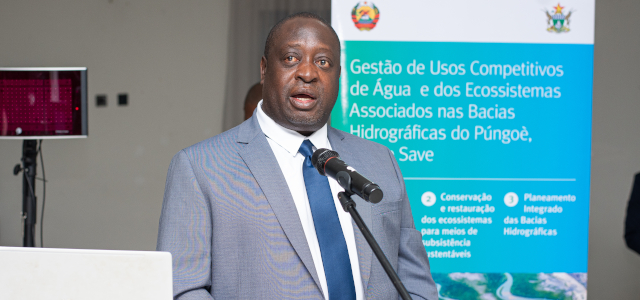
“The assessment determined how different aspects of the socio-economic and ecosystem context react to the Pungwe basin’s flows and levels of water utilization”, says Mr. Elisha Madamombe, BUPUSACOM Interim Executive Secretary and IUCN-GEF BUPUSA Regional Project Coordinator
The assessment established that the levels of water use in the basin are well below the annual average yield and that there is scope to develop the water resources of the basin without seriously compromising ecosystem functions and biodiversity.
The Basin monograph reported several bird species with threatened global concern status and more than 15 broad vegetation types (including mangroves) in the Pungwe Basin, with 3 of these being of conservation concern that are directly reliant on regular water flow. The two main protected conservation areas within the Pungwe Basin are Gorongosa National Park in Mozambique and Nyanga National Park in Zimbabwe. Most of the large mammals common to southern Africa exist in Gorongosa.
Cold-water species of fish dominate the upper parts of the river, where the water is mostly clear and of low productivity, while warm-water and marine fish species become more common in the lower reaches of the Pungwe.
The EFlows assessment also identified the Nhandugue River, the Urema catchment, and the Nhandare River as high biological diversity areas that should be prioritized for protection and maintained in near-natural condition to support migratory species and other ecosystem processes.
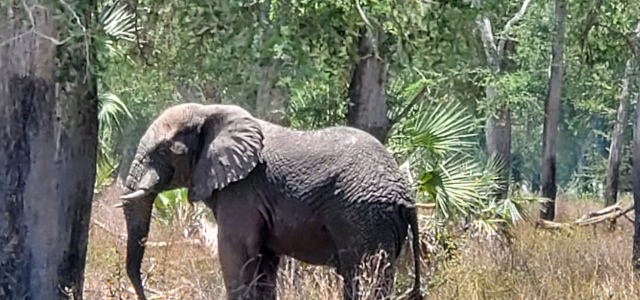
An elephant spotted in Gorongosa National Park, Mozambique.
The Pungwe River is an important source of water for irrigation agriculture, livestock production, forestry, domestic water supply, industry, and hydropower generation. Across the basin, aquatic ecosystems play a significant role in supporting rural livelihoods, for which fishing is an important socio-economic activity. The Pungwe River basin houses more than 50 species of 14 families of native freshwater fish which are important as a food source for one another and for birds, reptiles, and people.
In the middle and upper basin, fishing is mainly for subsistence, but in the floodplain and coastal zones, fishing is a major economic activity contributing significantly to household income. Fishing often results in growth overfishing (fish are harvested before they reach full reproductive potential), recruitment overfishing (most breeding adults have been removed), and ecosystem overfishing (entire trophic levels removed). In addition to other management actions, for example, the abolishment of small nets and mono-filament fishing nets, the EFlows assessment recommended that the two riparian states maintain flood flows in the river.
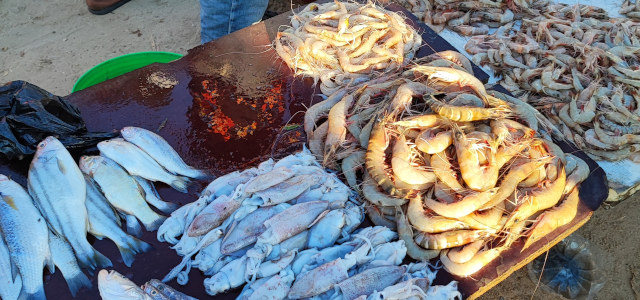
A wide variety of fish, molluscs, and crustaceans are sold on the beach at Mercado Praia Nova in Beira, Mozambique
Flooding is a common occurrence in the coastal areas, determining the biodiversity in the estuary as it promotes the growth of mangroves. Mangroves are extremely productive habitats that house a diversity of fish and invertebrate species and play a huge role in filtering and improving water quality. Moreover, they act as buffers against severe weather and also have a high recreational, cultural, and tourism value. While over-abstraction of freshwater poses a threat to mangroves, it has also been established that fish population in certain zones in the basin increases dramatically during periods of flooding and the marketing of fish is likely to provide a significant income.
Large-scale commercial and subsistence agriculture, artisanal, larger-scale sand and gold mining, wildlife, firewood harvesting, and charcoal production, have been picked as major contributors to environmental degradation and erosion. The resultant siltation causes deterioration of water quality, choking up of water pumps and irrigation systems, reduction of wetlands and grazing areas for animals, destruction of aquatic habitats, and an overall reduction in biodiversity within the basin.
The EFlows assessment identified rural and urban settlements (e.g., Beira), agriculture, afforestation, and gold panning as the main sources of estuary water pollution. Leaching of chemicals, including heavy metals, used in the gold mining process reduces the quality of water, risking humans and animals.
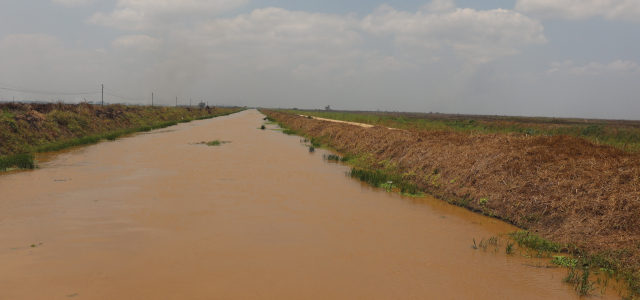
A channel into Tongaat Hulet sugar cane estates from the Pungwe River, the high turbidity is attributed largely to mining activities.
There is a heightened risk of eutrophication, which begins with an excessive influx of nutrients into estuaries and coastal waters. This, combined with low river inflows may lead to detrimental consequences such as harmful algal blooms, dead zones, and fish fatalities. Severe reduction in pH (acidification) also slows the growth of the fish and other creatures in the basin, leading to a reduced catch for commercial and recreational fisheries. The assessment established that the risk of eutrophication can be mitigated by maintaining > 6. 5m3 /s dry season inflows to the estuary and reducing nutrient inputs to the river.
Overall, the study recommended that water-resource development in the Pungwe Water-Sharing Agreement be combined with investments in environmental protection and sustainable utilisation of natural resources.The assessment will inform negotiations around clauses around transboundary water allocation and ecological flows in the Pungwe basin as provided by the Pungwe Water Sharing Agreement.
Photo credits: GEF- BUPUSA Project, Davison Saruchera, Melisa Mavenge Matavire ( IUAN) , Kevin Piertersen ( SADC GMI), Gwyn Letley ( Anchor Environmental).
